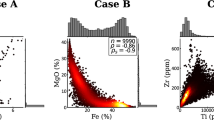Abstract
Covariance models provide the basic measure of spatial continuity in geostatistics. Traditionally, a closed-form analytical model is fitted to allow for interpolation of sample Covariance values while ensuring the positive definiteness condition. For cokriging, the modeling task is made even more difficult because of the restriction imposed by the linear coregionalization model. Bochner's theorem maps the positive definite constraints into much simpler constraints on the Fourier transform of the covariance, that is the density spectrum. Accordingly, we propose to transform the experimental (cross) covariance tables into quasidensity spectrum tables using Fast Fourier Transform (FFT). These quasidensity spectrum tables are then smoothed under constraints of positivity and unit sum. A backtransform (FFT) yields permissible (jointly) positive definite (cross) covariance tables. At no point is any analytical modeling called for and the algorithm is not restricted by the linear coregionalization model. A case study shows the proposed covariance modeling to be easier and much faster than the traditional analytical covariance modeling, yet yields comparable kriging or simulation results.
Similar content being viewed by others
REFERENCES
Almeida, A., and Journel, A., 1994, Joint simulation of multiple variables with a Markov-type coregionalization model: Math. Geology, v. 26,no. 10, p. 565–588.
Bochner, S., 1949, Fourier transform: Princeton Univ. Press, London, 219 p.
Bracewell, R., 1986, The Fourier transform and its application: Mc-Graw Hill, Singapore, 474 p.
Chatfield, C., 1996, The analysis of time series: an introduction: Chapman & Hall Ltd., London, 283 p.
Chu, J., 1993, Conditional fractal simulation, sequential indicator simulation, and interactive variogram modeling: unpubl. Doctoral dissertation, Stanford University, 147 p.
Deutsch, C., and Journel, A., 1997, Geostatistical software library and user's guide: Oxford Univ. Press, New York, 368 p.
Deutsch, C., 1996, Direct assessment of accuracy and precision, in Baffi, E., and Schofield, N., eds., Geostatistics Wollongong '96 (Vol. 1): Kluwer Academic Publ., Dordrecht, p. 115–125.
Goulard, M., 1989, Inference in a coregionalized model, in Armstrong, M., ed., Geostatistics (Vol. 1): Kluwer Academic Publ., Dordrecht, p. 397–408.
Journel, A., and Huijbregts, C., 1978, Mining geostatistics: Academic Press, San Diego, 600 p.
Journel, A., 1996, Deterministic geostatistics: A new visit, in Baffi, E., and Schofield, N., eds., Geostatistics Wollongong '96 (Vol. 1): Kluwer Academic Publ., Dordhrect, p. 174–187.
Pardo-Iguzquiza, E., and Chica-Olmo, M., 1993. The Fourier integral method: An efficient spectral method for simulation of random fields: Math. Geology, v. 25,no. 4, p. 177–217.
Rehman, S., 1995, Semiparametric modeling of cross-semiovariograms: unpubl. Doctoral dissertation, Georgia Institute of Technology, 143 p.
Sneddon, L., 1951, Fourier transforms: McGraw Hill, New York, 542 p.
Yao, T., Conditional spectral simulation with phase identification: Math. Geology, v. 30,no. 3, p. 285–308.
Author information
Authors and Affiliations
Rights and permissions
About this article
Cite this article
Yao, T., Journel, A.G. Automatic Modeling of (Cross) Covariance Tables Using Fast Fourier Transform. Mathematical Geology 30, 589–615 (1998). https://doi.org/10.1023/A:1022335100486
Issue Date:
DOI: https://doi.org/10.1023/A:1022335100486




